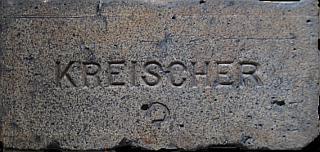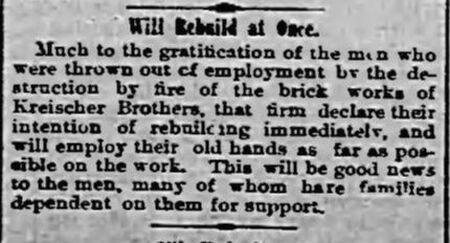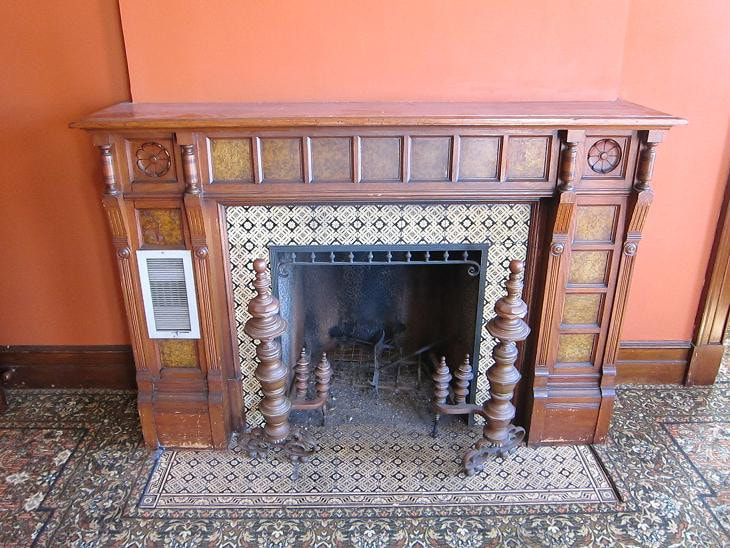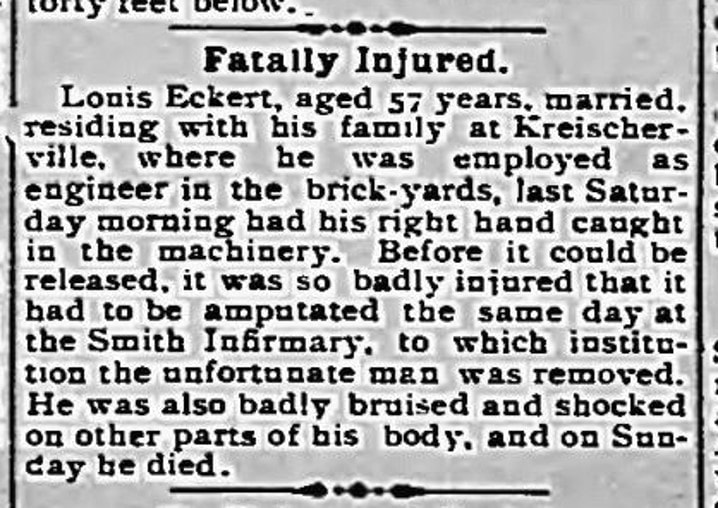Kreischer Mansion

Presently the Charles Kreischer Mansion sits on five acres of land atop Kriescher Hill on Arthur Kill Road in Charleston, Staten Island, NY. As of 2021, it's listed for $7.4 million. Restored to its former glory as a Stick style example of architecture, its looks exactly as what most people think of as a traditional, Victorian haunted house, the thing is… it really is haunted. If walls could talk, then the Kriescher Mansion could speak volumes about violence, murder, possible infidelity and it all started over 130 years ago.
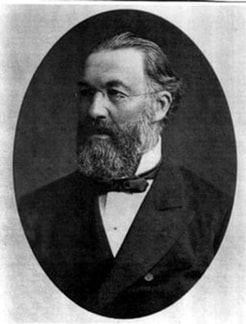 Balthasar Kreischer
Balthasar Kreischer
In 1854, Balthasar Kriescher a Bavarian immigrant who became wealthy with his brick making empire, moved to the area and established a factory. He provided housing and jobs to the citizens of Androvetteville as it was known then, and eventually the town was renamed to Kreischerville in his honor. He was generous to his workers but “was said to be an ‘unbending taskmaster’ and a strong paternal figure, who was very strict with his employees. Should one of the men miss a day’s work from a long evening of beer at a local tavern, Kreischer would go through town bellowing out the man’s name and telling him to get back to work”.
The business prospered, however in his personal life Balthasar had suffered a tremendous loss only a year before. In 1853, his wife Caroline had died within days of giving birth to their seventh child, a son they named Edward. Maybe she died due to complication in childbirth as did so many women of this time, or maybe it was heartbreak as well. Only four years before they had buried six year old Henry Kreischer in the family plot at Green-Wood Cemetery.
Balthasar was pragmatic and by 1858, he built himself a mansion which he named Fairview on a hill just east of Arthur Kill Road, which overlooked the town and the brick factory. He also had a new wife named Mathilda. They had two children, neither which survived into adulthood.
During this time he also built a church and a post office for the town.
The business prospered, however in his personal life Balthasar had suffered a tremendous loss only a year before. In 1853, his wife Caroline had died within days of giving birth to their seventh child, a son they named Edward. Maybe she died due to complication in childbirth as did so many women of this time, or maybe it was heartbreak as well. Only four years before they had buried six year old Henry Kreischer in the family plot at Green-Wood Cemetery.
Balthasar was pragmatic and by 1858, he built himself a mansion which he named Fairview on a hill just east of Arthur Kill Road, which overlooked the town and the brick factory. He also had a new wife named Mathilda. They had two children, neither which survived into adulthood.
During this time he also built a church and a post office for the town.
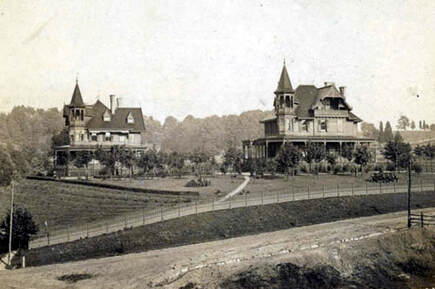 Edward and Charles Kreischer Mansions completed in 1885
Edward and Charles Kreischer Mansions completed in 1885
1877, was not a good year for Balthasar, Mathilda died and his factory burned down, and even though it was rebuilt, these events no doubt lead to him retiring in 1878. He turned over the reins of the business to his now adult sons George, Charles and Edward who were already members of the firm.
In 1884, construction started on two new mansions close to Balthasar’s Fairview villa, designed to be mirror images of the other. It’s not clear if Balthasar had them built for his sons, or if it was Charles and Edward who commissioned them to house their own families. Each of these brothers married sisters Antonia and Frieda Lanier. The houses were completed in 1885, and Balthasar died in 1886.
In 1884, construction started on two new mansions close to Balthasar’s Fairview villa, designed to be mirror images of the other. It’s not clear if Balthasar had them built for his sons, or if it was Charles and Edward who commissioned them to house their own families. Each of these brothers married sisters Antonia and Frieda Lanier. The houses were completed in 1885, and Balthasar died in 1886.
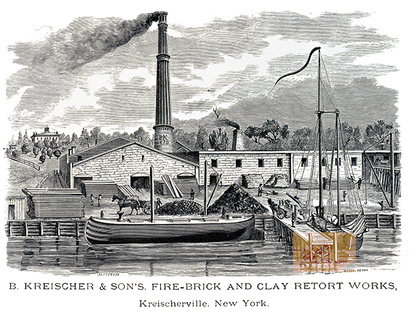 Kreischer & Sons Factory c.1874
Kreischer & Sons Factory c.1874
Balthasar’s passing set in motion unfortunate and tragic circumstances that he could not have foreseen. Upon his death he divided his business between five of his surviving children. His oldest son George bought the interests in the business from his two sisters, thus giving him control of the immense brick works business. He then dismissed his brother Charles who had been in charge, and appointed Edward and a stranger named William Linderoth as superintendent.
In 1891, and after being dismissed by George or resigning of his own volition, Charles left on an extended trip to Europe. He then went to work for the Weber Brick Co. of Perth Amboy. During this time the factory burnt down for the second time and it was rebuilt, however the Kreischer business was in decline.
In June of 1894, Edward Kreischer’s committed suicide by shooting himself in the head. A young employee found him not far from the factory. The reasons given were disagreements with his older brother George Kreischer and William Linderoth; however the family claimed the relationship between the brothers was a happy one. Testimony from family friends and workers at the factory point to everything but that. William Linderoth was so disliked he had been attacked by the factory workers and injured, and he was told to leave the town when rumors were circulating that he was to blame for Edward’s suicide.
In 1891, and after being dismissed by George or resigning of his own volition, Charles left on an extended trip to Europe. He then went to work for the Weber Brick Co. of Perth Amboy. During this time the factory burnt down for the second time and it was rebuilt, however the Kreischer business was in decline.
In June of 1894, Edward Kreischer’s committed suicide by shooting himself in the head. A young employee found him not far from the factory. The reasons given were disagreements with his older brother George Kreischer and William Linderoth; however the family claimed the relationship between the brothers was a happy one. Testimony from family friends and workers at the factory point to everything but that. William Linderoth was so disliked he had been attacked by the factory workers and injured, and he was told to leave the town when rumors were circulating that he was to blame for Edward’s suicide.
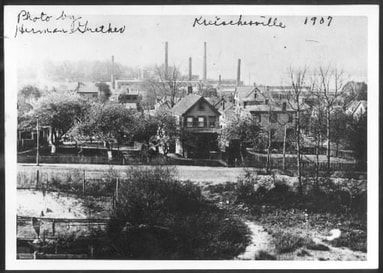 Kreischerville, Staten Island c.1907
Kreischerville, Staten Island c.1907
Behind the scenes, and the Victorian morality of the times, rumors swirled that Edward’s wife Frieda was allegedly having an affair with a Dr. Walker Washington who lived in nearby Tottenville. She was reported as being prostrate with grief when she learned of Edward’s suicide, but whether the stories of the affair were true or not, within eighteen months she married Dr. Washington on Christmas Eve, 1895.
Could this have contributed to Edward’s decision to take his own life? Possibly, but whatever devils drove him to take this action, he apparently did not find the peace he sought as he is reported to be one of the spirits haunting his brother's home.
His widow Frieda is thought to be the female ghost seen in the home, however she lived for many more years, and passed away in 1923. Her husband Walker died in 1939.
Could this have contributed to Edward’s decision to take his own life? Possibly, but whatever devils drove him to take this action, he apparently did not find the peace he sought as he is reported to be one of the spirits haunting his brother's home.
His widow Frieda is thought to be the female ghost seen in the home, however she lived for many more years, and passed away in 1923. Her husband Walker died in 1939.
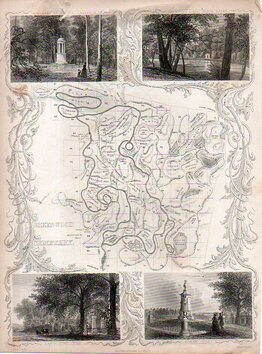 Map of Greenwood Cemetery, Brooklyn where many of the Kreischer family are buries
Map of Greenwood Cemetery, Brooklyn where many of the Kreischer family are buries
Edward’s suicide was the beginning of the end for the Kreischers and their business, and in 1899, they declared bankruptcy and the factory was won at auction by Captain Peter Androvette a member of a prominent family who lived in the area since the 1700s.
In 1916, as WWI was drawing to a close, anti-German sentiment was high and the name of the town was changed from Kreischerville to its present name of Charleston in order to honor Charles but not sound so Germanic.
The Androvettes kept the name of the company but by 1927, the factory had closed and it was razed in 1936.
George Kreischer, who might have played a part in the suicide of his younger brother Edward died in 1910, in his home in Manhattan where he lived for many years,
Charles Kreischer, the last surviving son had also moved to New York by the time he passed away in 1917.
Balthasar’s youngest daughter Louisa had married into the Steinway family (of Steinway & Sons piano fame), and moved away. Many of the members of both of these prominent families are buried in Green-Wood Cemetery in Brooklyn.
In 1916, as WWI was drawing to a close, anti-German sentiment was high and the name of the town was changed from Kreischerville to its present name of Charleston in order to honor Charles but not sound so Germanic.
The Androvettes kept the name of the company but by 1927, the factory had closed and it was razed in 1936.
George Kreischer, who might have played a part in the suicide of his younger brother Edward died in 1910, in his home in Manhattan where he lived for many years,
Charles Kreischer, the last surviving son had also moved to New York by the time he passed away in 1917.
Balthasar’s youngest daughter Louisa had married into the Steinway family (of Steinway & Sons piano fame), and moved away. Many of the members of both of these prominent families are buried in Green-Wood Cemetery in Brooklyn.
 Kreischer Mansion c.1987
Kreischer Mansion c.1987
The homes built by the Kreischers, left unattended fell into disrepair and Balthasar’s Fairview mansion burned down in the 1930s. Edward’s mansion was torn down in the 1940s, leaving only Charles’ home sitting atop Kreischer Hill. Neither one of these events claimed any lives, and records cannot be found to substantiate the claim that one of the Kreischer sons and his wife died in a fire. Another story which seems to have no truth to it is the death of a German cook who either committed suicide by hanging, or was murdered in the kitchen of one of the homes in the early 1900s.
In 1968, the Kreischer Mansion was made into a landmark, thus sparing it from demolition in the future, and in 1982, it was placed on the National Register of Historic Places.
A view of the property during the 1980s shows that it stood unattended with a locked gate at the entrance, and the shrubbery around it overgrown and blocking a full view of the house from the street.
Throughout the years the house had gained a reputation as being haunted, and in the late 1990s, when it was a Victorian style restaurant it was allegedly run as a front for the mob. Employees and patrons reported spooky experiences while working there. A busboy described hearing sounds of arguing and doors shutting when he went down to the basement which he couldn’t account for. Others complained of being touched and grabbed.
In 1968, the Kreischer Mansion was made into a landmark, thus sparing it from demolition in the future, and in 1982, it was placed on the National Register of Historic Places.
A view of the property during the 1980s shows that it stood unattended with a locked gate at the entrance, and the shrubbery around it overgrown and blocking a full view of the house from the street.
Throughout the years the house had gained a reputation as being haunted, and in the late 1990s, when it was a Victorian style restaurant it was allegedly run as a front for the mob. Employees and patrons reported spooky experiences while working there. A busboy described hearing sounds of arguing and doors shutting when he went down to the basement which he couldn’t account for. Others complained of being touched and grabbed.
 Kreischer Mansion under renovations
Kreischer Mansion under renovations
By 1999, the house was once again deserted after the restaurant failed. In 2000, Isaac Yomtovian bought it and started to restore the property to its former grandeur, even changing its exterior color from white to a military green and yellow.
Mr. Yomtovian did not live in the area, and hired an ex-marine, Joseph "Joe Black" Young as caretaker to look after the property. He did not know that Joe Black had connections to organized crime, and had been dishonorably discharged from the armed forces after only a few months for going AWOL.
In 2005, Joe Black was hired by the mob to kill Robert McKelvey who had his own ties to organized crime and supposedly owed money. An isolated mansion under renovation, where he was the only occupant probably seemed the perfect place to carry this out. Joe and Michael Maggio lured Robert McKelvey to the mansion. Once there Joe attacked him, and McKelvey died only after he had been stabbed, strangled and finally drowned in an ornamental pool close to the entrance of the home.
Afterwards Stefan Cicale and Jose Garcia were called in to help dispose of the body. McKelvey’s remains were left in a shed while they went to Home Depot for supplies. Upon returning to the house, the body was dragged into the kitchen and placed on a mattress where it was bled out in order to facilitate dismemberment. The body parts were then taken into the cellar and incinerated in the furnace. A few days after he had disappeared, McKelvey’s sister filed a missing person’s report. However a year went by and no one except the killers knew exactly what had become of McKelvey, and that his charred remains which consisted of ashes, a bone and teeth were disposed of in a well just outside the entrance to the house.
This homicide might have gone undiscovered except that a year later one of the participants in the murder, Stefan Cicale turned informant and told the FBI about what occurred.
Ironically the fact that the house was being renovated worked in Joe’s favor when the furnace was replaced with a newer one, thus eliminating a source of evidence, but even that didn’t stop Joseph Young from being convicted and sentenced to life in 2009. Gino Galestro who ordered the hit was sentenced to 20 years. Cicale was put in the witness protection program and let off for time served.
Mr. Yomtovian did not live in the area, and hired an ex-marine, Joseph "Joe Black" Young as caretaker to look after the property. He did not know that Joe Black had connections to organized crime, and had been dishonorably discharged from the armed forces after only a few months for going AWOL.
In 2005, Joe Black was hired by the mob to kill Robert McKelvey who had his own ties to organized crime and supposedly owed money. An isolated mansion under renovation, where he was the only occupant probably seemed the perfect place to carry this out. Joe and Michael Maggio lured Robert McKelvey to the mansion. Once there Joe attacked him, and McKelvey died only after he had been stabbed, strangled and finally drowned in an ornamental pool close to the entrance of the home.
Afterwards Stefan Cicale and Jose Garcia were called in to help dispose of the body. McKelvey’s remains were left in a shed while they went to Home Depot for supplies. Upon returning to the house, the body was dragged into the kitchen and placed on a mattress where it was bled out in order to facilitate dismemberment. The body parts were then taken into the cellar and incinerated in the furnace. A few days after he had disappeared, McKelvey’s sister filed a missing person’s report. However a year went by and no one except the killers knew exactly what had become of McKelvey, and that his charred remains which consisted of ashes, a bone and teeth were disposed of in a well just outside the entrance to the house.
This homicide might have gone undiscovered except that a year later one of the participants in the murder, Stefan Cicale turned informant and told the FBI about what occurred.
Ironically the fact that the house was being renovated worked in Joe’s favor when the furnace was replaced with a newer one, thus eliminating a source of evidence, but even that didn’t stop Joseph Young from being convicted and sentenced to life in 2009. Gino Galestro who ordered the hit was sentenced to 20 years. Cicale was put in the witness protection program and let off for time served.
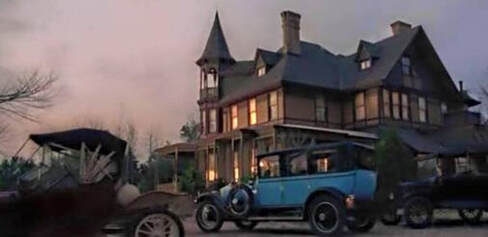 Kresicher Mansion during the filming of Boardwalk Empire
Kresicher Mansion during the filming of Boardwalk Empire
These events did not detract from the mansion’s appeal and in 2009, scenes from HBO’s Boardwalk Empire was filmed there.
The scene where Richard Harrow played by Jack Huston murders Franklin Werner played by James Riordan was shot on the second floor. Boardwalk Empire's cast and crew reported several strange happenings over the 12 hour shooting of the scene, including props moving without explanation and cameras turning themselves on and off. Members of the crew reported seeing a little girl dressed in period clothing who seemed to be lost. There were only two actors in the scene, both men and there were no "extras" called for background.
In 2016, Discovery Channel’s Paranormal Lockdown featured the site in the 6th episode of the series.
So who are the ghosts walking the halls of the Kreischer Mansion? Edward Kreischer is probably one of them. You might think the obvious reason is that he committed suicide, but it might have more to do with the actual reasons he did it, or even if he did commit suicide at all. The newspapers who reported on this incident cite that workers present at the factory that morning, claimed he appeared to be in a good mood just a short time before his body was discovered. Even then this was considered a suicide under mysterious circumstances. He was only forty three years old, wealthy, married with an eleven year old son, and only had his older brother George to answer to.
His grief-stricken brother Charles supposedly held séances in order to contact him, and get the most important of answers, which was why he had taken his life. These séances are thought to be another source for the hauntings, and considering how popular spiritualism was at this time, there was probably more than one attempt to contact Edward. The problem could have arisen if an inexperienced medium, or just a plain charlatan inadvertently opened a doorway to the spirit world, which remained open, allowing any and all entities access to come and go as they pleased.
The scene where Richard Harrow played by Jack Huston murders Franklin Werner played by James Riordan was shot on the second floor. Boardwalk Empire's cast and crew reported several strange happenings over the 12 hour shooting of the scene, including props moving without explanation and cameras turning themselves on and off. Members of the crew reported seeing a little girl dressed in period clothing who seemed to be lost. There were only two actors in the scene, both men and there were no "extras" called for background.
In 2016, Discovery Channel’s Paranormal Lockdown featured the site in the 6th episode of the series.
So who are the ghosts walking the halls of the Kreischer Mansion? Edward Kreischer is probably one of them. You might think the obvious reason is that he committed suicide, but it might have more to do with the actual reasons he did it, or even if he did commit suicide at all. The newspapers who reported on this incident cite that workers present at the factory that morning, claimed he appeared to be in a good mood just a short time before his body was discovered. Even then this was considered a suicide under mysterious circumstances. He was only forty three years old, wealthy, married with an eleven year old son, and only had his older brother George to answer to.
His grief-stricken brother Charles supposedly held séances in order to contact him, and get the most important of answers, which was why he had taken his life. These séances are thought to be another source for the hauntings, and considering how popular spiritualism was at this time, there was probably more than one attempt to contact Edward. The problem could have arisen if an inexperienced medium, or just a plain charlatan inadvertently opened a doorway to the spirit world, which remained open, allowing any and all entities access to come and go as they pleased.
 Gates outside the property after it fell into disrepair
Gates outside the property after it fell into disrepair
As to the lady ghost who’s been heard wailing, and who appeared to former owner Joe McBratney in the 1990s, the bet is on Mathilda Kreischer, not Frieda. Why you ask? Well Frieda whether heartbroken or not, married someone else shortly thereafter and lived for many more years, however Mathilda was a different story. She was only 52 years old when she died in 1877. By then she had buried two children, one of them Alfred who died in 1863, when he was only 5 years old. He could be the child ghost heard when all is quiet there. Mathilda lived in the Fairview Mansion, only a stone’s throw from this location, and there’s no denying her connection with her stepchildren and their families, since they were so young themselves when she married Balthasar and became a mother figure for them.
And then there is what is called the Forgotten Ones. These are all the people who lived their lives anonymously inside the walls of the Kreischer Mansion, or worked in the Kreischer Brick Factory which was less than a 1/2 a mile from the house. They experienced moments of extreme emotion, whether in happiness or grief, in the shadow of their wealthy patrons. How many servants lived in this home throughout the years? How many secrets and tragedies befell them, possibly leaving some stuck in limbo, yearning for someone to explain what happened to them, or an opportunity to tell their story? They could be the source of residual sounds and feelings; their imprint part of the emotional fabric of this place.
Maybe there were others like Robert McKelvey who met a gruesome end, in or around the mansion, however there were never circumstances which allowed the truth of their demise to come to light, as it did in this homicide case. You only have to visit sites like the Doe Network, which catalogs missing persons and unidentified human remains to understand how a person can be killed, and never be found, or in some cases identified as a victim. These “unknowns” account for many intelligent hauntings and are found in locations where least expected. There’s a plethora of candidates who gave the Kreischer Mansion its reputation for being haunted throughout its long history, long before McKelvey was killed there, and if his spirit lingers on, he must be looking around and asking, “Who are all these people?!”
And then there is what is called the Forgotten Ones. These are all the people who lived their lives anonymously inside the walls of the Kreischer Mansion, or worked in the Kreischer Brick Factory which was less than a 1/2 a mile from the house. They experienced moments of extreme emotion, whether in happiness or grief, in the shadow of their wealthy patrons. How many servants lived in this home throughout the years? How many secrets and tragedies befell them, possibly leaving some stuck in limbo, yearning for someone to explain what happened to them, or an opportunity to tell their story? They could be the source of residual sounds and feelings; their imprint part of the emotional fabric of this place.
Maybe there were others like Robert McKelvey who met a gruesome end, in or around the mansion, however there were never circumstances which allowed the truth of their demise to come to light, as it did in this homicide case. You only have to visit sites like the Doe Network, which catalogs missing persons and unidentified human remains to understand how a person can be killed, and never be found, or in some cases identified as a victim. These “unknowns” account for many intelligent hauntings and are found in locations where least expected. There’s a plethora of candidates who gave the Kreischer Mansion its reputation for being haunted throughout its long history, long before McKelvey was killed there, and if his spirit lingers on, he must be looking around and asking, “Who are all these people?!”
UPDATE - April, 2022, property listed for sale at $8,990,900. July, 2022, the listing was removed.
